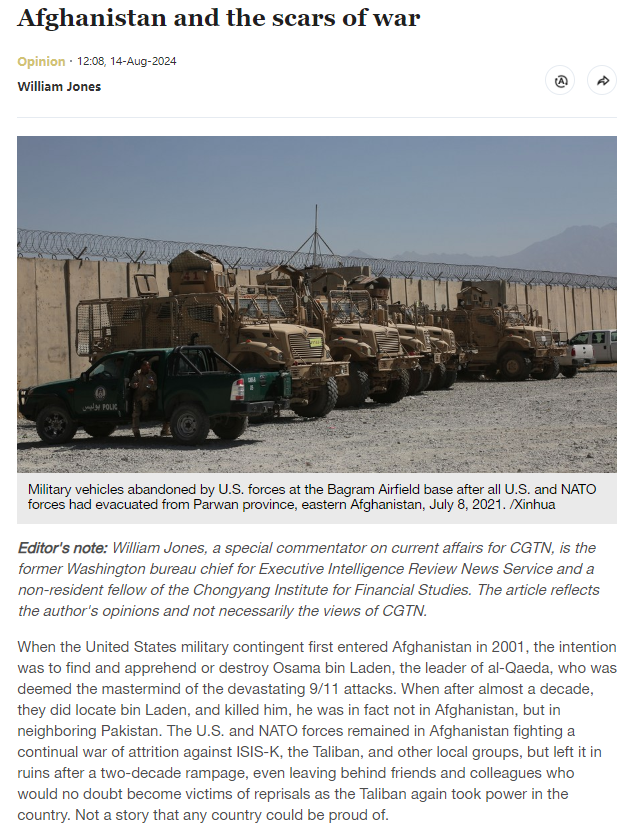LATEST INSIGHTS
Your Present Location: LATEST INSIGHTS[CGTN] William Jones: Afghanistan and the scars of war
Source: CGTN Published: 2024-08-14

By William Jones
When the United States military contingent first entered Afghanistan in 2001, the intention was to find and apprehend or destroy Osama bin Laden, the leader of al-Qaeda, who was deemed the mastermind of the devastating 9/11 attacks. When after almost a decade, they did locate bin Laden, and killed him, he was in fact not in Afghanistan, but in neighboring Pakistan. The U.S. and NATO forces remained in Afghanistan fighting a continual war of attrition against ISIS-K, the Taliban, and other local groups, but left it in ruins after a two-decade rampage, even leaving behind friends and colleagues who would no doubt become victims of reprisals as the Taliban again took power in the country. Not a story that any country could be proud of.
It also left a new generation here in America with the same kind of trauma that my generation had experienced in the Vietnam War. The U.S. didn't go in for any 'nation-building' in Afghanistan as this has not been the task of U.S. foreign policy – and probably shouldn't be. Any infrastructural development that might have been accomplished was always done to assist the military mission. They did set up a group of Western-educated Afghans to form a government, which we later abandoned to their fate, but the U.S. was never able to create a basis among the general population. Few 'conqueroring nations' have succeeded in doing so.
The U.S. spent $2.3 trillion in Afghanistan and lost 2,324 military personnel, 3,917 contractors, and 1,144 allied troops. Afghan losses were absolutely staggering: 70,000 military and police deaths, 46,319 civilians, and 53,000 opposition fighters also died.
For a long time, the U.S. absolutely refused to talk with the Taliban, although we had had something of a working relationship with the Taliban before 9/11. They too were threatened by the more radical ISIS-K fighters. Although the U.S. today does recognize the Taliban government, they are having great difficulty in working with them on the 'humanitarian' issues on which the U.S. has committed to help.
In 2011, the U.S. discovered the hiding place of Osama bin Laden in Pakistan and went in with special forces, killing bin Laden and his family. The ostensible reason for the invasion of Afghanistan was now gone, and therefore the U.S. had no reason to remain. They felt, however, that they had at least established an efficient Afghan government with a military and police force, but spent the next ten years in the country training them. Nevertheless, during this second decade of effective occupation, the Taliban was still making headway.
In 2020, the U.S. had to sign an agreement with the regime it had established saying that they would begin withdrawing all their forces. During the time of their withdrawal, the U.S.-trained Afghan forces proved unable to prevent the advances of the Taliban, and by the time U.S. President Joe Biden withdrew the last of the troops, it was clear that the Taliban were in charge of the country.
The U.S. left behind a shattered nation, and there is little sign at this juncture that they will do anything to help the Taliban-led nation get back on its feet. There are major deficiencies in food and water. Afghanistan's average annual precipitation is around 213 billion cubic meters, with an annual surface water potential of about 57 billion cubic meters. This would be sufficient for the nation once water management systems of dams and irrigation networks are fully built out.
There is no integrated rail grid in Afghanistan, and only a few hundred kilometers of railway in all, although there is continued talk about building the trans-Afghan railway. This would run from Uzbekistan through Mazar e-Sharif and Kabul into Pakistan, and link up with the China-Pakistan Economic Corridor. The Khaf-Herat railway is a 225-kilometer-long cross-border line between Iran and Afghanistan and there is a small but important rail link between Afghanistan and Turkmenistan.
With the tremendous supply of landless farmworkers, there is an abundant supply of reserve labor which could be put to work to help rebuild the nation. There is support for these efforts from Afghanistan's neighbors, and one neighbor in particular, China, is offering help in the reconstruction process. But the one country that bears the most responsibility for the devastating situation remains aloof.
While the U.S. now has relations with the Taliban and is a contributor to humanitarian aid, Afghanistan is not as high on its radar screen as it might merit given the amount of blood and treasure (on both sides) that has been spilt in the unfortunate occupation. Helping revive the Afghan economy and the Afghan nation as a viable part of the world community could perhaps provide some redemption for the sins of America's past.
Key Words: William Jones, RDCY, Afghanistan, USA























































































 京公网安备 11010802037854号
京公网安备 11010802037854号





